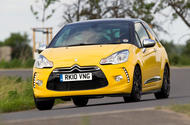The original DS3 was badged as a Citroën before DS’s breakaway in 2014
French premium brand ditched original DS 3 in 2019, as it pushed to capitalise on crossover segment
The boss of French premium car brand DS says a new supermini could be on the cards as it ramps up plans to renew its smallest offering, the DS 3 Crossback.
The crossover replaced the former DS 3 supermini – first sold as a Citroën – in 2019 in a bid to capitalise on the hugely popular and still growing B-SUV crossover hatchback segment.
But as the car maker looks to its next generation – especially ahead of its 2024 full-electrification plan – boss Béatrice Foucher told Autocar that she wouldn’t rule out a return to the 3’s roots, adding that the original 3 “was very successful in the UK”.
If it were to return, it would do so with an electric powertrain and sit on parent brand Stellantis’s STLA Small platform, which is due to be released halfway through the decade.
Foucher said: “We are working on the renewal of the DS 3, and when we say ‘renewal’, it doesn’t say that we will renew the car strictly as it is today.
“The purpose of renewing is to say: ‘Okay, we have customers [already], and we [are also] looking at some new customers we would like to talk to with a new car, and what would be the best product in order to do so?’
“[We need to] capitalise on what has been done. This is what we are thinking about for the time being.”
However, a smaller car comes with risks, said Foucher, with comparatively high production costs per unit, and therefore lofty retail prices.
She added that the brand would also have to look at what the market wants, as a new supermini would buck an automotive trend. Most firms, including Ford and Honda, have shifted their focus away from smaller cars in favour of more popular crossovers and bigger SUVs.
“At the end of the day, when looking at the premium market, it is more difficult to sell small cars than big ones, obviously because when you pay a lot for big ones, you have the status, and you have the volume for the price, so the cost for the volume is appropriate,” said Foucher.
“But when you have small cars, this is more difficult to argue. It means that it is always a difficult equation to have a small car while being a premium brand.”
Source: Autocar
